 In my last post, I found myself in the ancient city of Xi'an, ready to encounter what lay ahead: the clay statue remains of the ancient Qin Dynasty warriors!
In my last post, I found myself in the ancient city of Xi'an, ready to encounter what lay ahead: the clay statue remains of the ancient Qin Dynasty warriors!As a very short history lesson, the Qin Dynasty united China 2200 years ago, and set about standardizing the written language, measurements, culture, and so forth. They also ruled heavy-handedly, and enacted a large number of expensive, fanciful public works - the secret Terra Cotta Warrior burial chamber, searches for immortality magic, and the unification of many smaller walls into the Great Wall were a few of them. Ultimately the dynasty only lasted twenty years, and the Terra Cotta Warrior Site never was uncovered. It was forgotten to history until its discovery in the 1970s, by farmers digging a well - the actual site lies in the rural suburbs of Xi'an city.
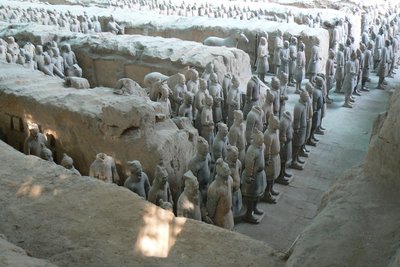
Again I'll talk about Imperial Chinese historical sites in terms of quantity: while the statues were memorable, individually made with a great skill, what most impresses in the scope of the project - the statues just go on and on, there's thousands of them. The first (and by far the largest) dig is located inside what seems like an airplane hangar:
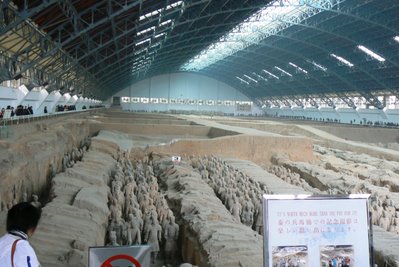
You can see that that it's not only soldiers. Terra-Cotta Horses were also buried, they were carrying chariots that have long since decayed.

Behind the horses can be made out the outline of clay sculptures, still being assembled. As solid as the sculptures seem in the above picture, all the terra cotta warriors had been smashed to bits. Thousands of years ago the statues had been originally housed in wooden structures, the roofs have long since collapsed.
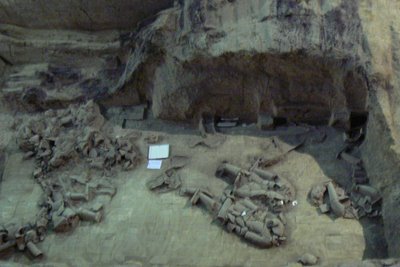
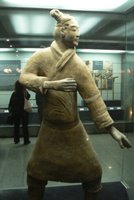 Bringing the statues back together looks like an amazingly painstaking process, and even now the large majority of the site is unexcavated - not only that, but there are other nearby Terra-Cotta sites that haven't even been touched yet! It's such a large job, with new sites still being discovered, that I don't expect the work to be finished in my lifetime.
Bringing the statues back together looks like an amazingly painstaking process, and even now the large majority of the site is unexcavated - not only that, but there are other nearby Terra-Cotta sites that haven't even been touched yet! It's such a large job, with new sites still being discovered, that I don't expect the work to be finished in my lifetime.Once outside the excavation sites, there's a huge industry of hawkers aggressively pushing small-scale Terra-Cotta Warriors, latching on parasitically, starting with high-ball prices and quickly dropping to prices so ridiculously cheap you almost wanted to get them as a whim. You can see them ahead...waiting...
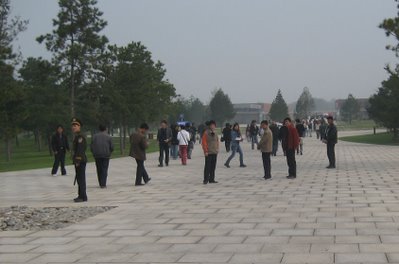
Also! On the walk to the parking lot, there was a ridiculously lengthy procession of newly constructed one and two story buildings. They looked very plain, something like an office park or an off-market shopping center. They were all empty, except for people with tables out front, selling fruit and silly tourist junk. As the walk went on and on, it felt eerie, like walking through a ghost city. I'm not sure how they expect to full so many buildings in such a remote area, I imagine they hope future tourists will stay entirely in this complex, not even bothering with the trip to Xi'an proper.
 I also visited another excavation site, Banpo Neolithic Village. It's ancient, nearly six thousand years old, and naturally there's a lot less to see: a few clay pieces, burial sites, foundations of houses, etc. To my inexpert eye there seems to be some connection to a more modern China, but how they fit in exactly is unclear. As with the Terra-Cotta Warriors site, the excavation is still in process, they're less than half finished.
I also visited another excavation site, Banpo Neolithic Village. It's ancient, nearly six thousand years old, and naturally there's a lot less to see: a few clay pieces, burial sites, foundations of houses, etc. To my inexpert eye there seems to be some connection to a more modern China, but how they fit in exactly is unclear. As with the Terra-Cotta Warriors site, the excavation is still in process, they're less than half finished.Finally, I had a quick look at Xi'an Shaanxi History Museum, where Shaanxi is the name of the Prefecture. I don't have much to say, other than that there were many interesting items:
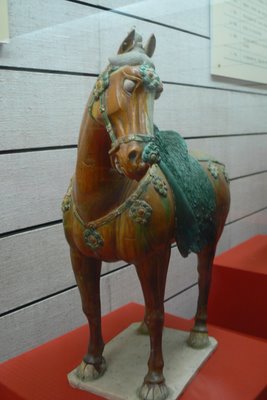
No comments:
Post a Comment